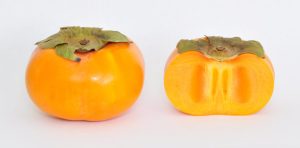Have you ever eaten something for the first time, only to wonder why you’d never given the morsel a second thought? This is precisely what happened with a lowly little persimmon that found its way to my heart.

(Photo by Joe Ravi/CC BY-SA 3.0)
Persimmons were always a part of the autumn produce section of the supermarket, but I never thought to try them. Squatty and orange with the appearance of a tomato, they never really appealed to me. I had no recipes for the fruit, nor did I want to venture out of my usual repertoire of produce, save for the pomegranate that quickly became our daughter’s favorite fruit of all time. Everything I thought about persimmons evaporated when Hubby brought home a brown paper tote bag that was literally overflowing with those orange fruits, courtesy of some of our lifelong friends and her dad’s backyard tree.
It must have been a banner year for persimmons, because our friends told my husband that they literally had “crates” of the fruit that would surely rot if not shared. I pulled a rather unripe fruit from the bag and gave it a puzzled look. Should I bite into it? Should the fruit be sliced and peeled? Would we be able to tolerate the taste? What was I going to do with all that produce?
Unripe persimmons are yellow and have a bitter flavor. I found that there was quite a crunch or snap to the fruit as I cut through the thin yellow skin. I offered a piece to my husband, who took a bite and chewed heartily. “It doesn’t have a taste,” he complained. I took a bite and agreed with him.
I ate two fruits daily until the bag was half gone. By that point, I had a steady habit going. The fruits began to ripen in the bag, which yielded a wonderfully sweet flavor. They were so juicy that I had to eat them over the kitchen sink. The juice ran down my hands and into the sleeves of my sweater, but I could care less. I had no idea of the deliciousness that I had been missing my whole life.
I did a little research, because I wanted to find a recipe for which to use those beautiful persimmons. Recipes popped up for persimmon jam, persimmon cake and even persimmon in salads. Persimmon pudding visions danced in my head as my mouth salivated in anticipation. There was even a recipe for frozen persimmon custard and a broiled persimmon recipe that was stuffed with mascarpone. Drizzle a little honey for added sweetness and you had a delicious end to any meal. Yummers.
For Thanksgiving, I took a few persimmons and diced them into perfect little chunks. I mixed them with the vegan chicken that I had purchased from Stop and Shop the week before and sauteed the combination until soft. When I added a gluten-free, vegan gravy atop the persimmons and vegan “chick’n”, it was a taste that could be considered “food of the gods.” It really was THAT GOOD.
We ran out of persimmons shortly thereafter, thanks to my now three-a-day habit. A meal without a persimmon quickly became a “day without sunshine.” I mentioned this in a post on Facebook as I bit into the final fruit with a bit of glumness. What would I do without those cheery fruits to brighten my meals?
The following week, our friend handed my husband another bag with at least 20 more persimmons. These were even more ripe and tasted literally like biting into a honeycomb. Who needed candy when one could enjoy nature’s bounty? Or rather, my friends’ bounty?
A Japanese persimmon is about 93 calories. High in potassium with a whopping 273 grams, it also contains almost six grams of fiber and 21 grams of naturally occurring sugars. Persimmons are also high in beta carotene, which is an excellent mineral for eye health and immunity. Vitamin C, folate, phosphorus, magnesium and calcium are also abundant in the humble persimmon. The fall fruit has been touted as a promoter of brain health, protector of vision, supporter of heart health, risk reducer for osteoporosis and may help prevent colon cancer. There are both astringent and non-astringent varieties, so be certain to purchase Fuyu or non-astringent persimmons.
The next time you are perusing the produce aisle, try a persimmon or two. Make sure that they are plump but not firm with a glossy skin that is free of black spots or “blemishes.” They have a short season, from September through November, though you may find them at farmer’s markets or specialty ethnic markets. Adding a persimmon to any dish adds a pop of color and wonderful health benefits.
Thank you, John and Grace, for your generosity and for introducing me to this wonderful little fruit. Though the season is almost over, it may be worth it to try www.Nuts.com’s dried persimmons if I need a little taste before next September.
Patty Servidio is an Anton Media Group columnist.






























